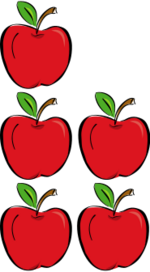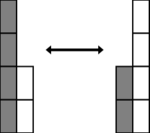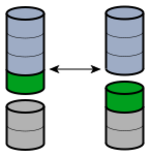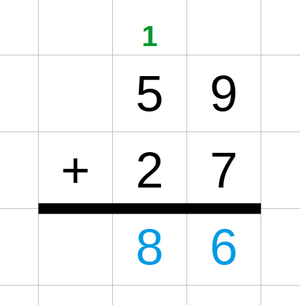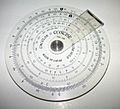Addition facts for kids
Addition is one of the four basic operations in arithmetic, along with subtraction, multiplication, and division. We use the plus sign (+) to show addition. When you add two numbers, the result is called the sum.
For example, if you have 3 apples and you get 2 more apples, you have 5 apples in total. We write this as a math problem: 3 + 2 = 5. This is read as "three plus two equals five."
Addition isn't just for counting things you can see. It also works with all kinds of numbers, like integers (positive and negative whole numbers), real numbers, and even more abstract things in algebra like vectors and matrices.
Addition has some simple but important rules. For example, the order you add numbers in doesn't change the answer (this is called being commutative). Also, when you add zero to a number, the number stays the same. Learning to add is one of the first steps in math, and even modern computers are designed to perform addition very quickly.
Contents
How to Write Addition
Addition is written using the plus sign (+) between the numbers you are adding. The answer is shown with an equals sign (=). For example:  ("one plus two equals three")
("one plus two equals three")
The numbers being added together are called addends or terms. The final answer is called the sum. In the example above, 1 and 2 are the addends, and 3 is the sum.
Sometimes, you might see a whole number and a fraction written together, like  . This is a mixed number and means
. This is a mixed number and means  , or 3.5.
, or 3.5.
The Rules of Addition
Addition follows a few simple rules that make it easy to work with.
Order Doesn't Matter (Commutative Property)
Addition is commutative, which means you can switch the order of the numbers and still get the same answer.  For example, 4 + 2 gives you the same sum as 2 + 4. Both equal 6.
For example, 4 + 2 gives you the same sum as 2 + 4. Both equal 6.
Grouping Doesn't Matter (Associative Property)
Addition is associative. This means that when you add three or more numbers, it doesn't matter how you group them.  For example, if you are adding 1, 2, and 3, you can add 1 and 2 first, or you can add 2 and 3 first. The final sum will be the same.
For example, if you are adding 1, 2, and 3, you can add 1 and 2 first, or you can add 2 and 3 first. The final sum will be the same. 

Adding Zero (Identity Property)
When you add zero to any number, the number doesn't change. Zero is called the identity element for addition.  For example, 5 + 0 = 5.
For example, 5 + 0 = 5.
Adding with Units
To add physical amounts, they must have the same units. For example, you can add 50 milliliters to 150 milliliters to get 200 milliliters. But you can't add 3 meters to 4 square meters because the units are different and measure different things (length vs. area).
How We Add Numbers
Learning to Add by Counting
Most children first learn to add by counting. If you ask a young child to solve 2 + 3, they might use their fingers or draw objects to count the total.
A common strategy is "counting-on." To find 2 + 3, a child might start at 2 and then count three more numbers: "three, four, five." As they get better, they learn to start with the bigger number to count less. For 2 + 3, they would start at 3 and count: "four, five."
Mastering Single-Digit Addition
To add bigger numbers, you first need to know how to add single-digit numbers (0 through 9). These are often learned using an addition table.
| + | 0 | 1 | 2 | 3 | 4 | 5 | 6 | 7 | 8 | 9 |
|---|---|---|---|---|---|---|---|---|---|---|
| 0 | 0 | 1 | 2 | 3 | 4 | 5 | 6 | 7 | 8 | 9 |
| 1 | 1 | 2 | 3 | 4 | 5 | 6 | 7 | 8 | 9 | 10 |
| 2 | 2 | 3 | 4 | 5 | 6 | 7 | 8 | 9 | 10 | 11 |
| 3 | 3 | 4 | 5 | 6 | 7 | 8 | 9 | 10 | 11 | 12 |
| 4 | 4 | 5 | 6 | 7 | 8 | 9 | 10 | 11 | 12 | 13 |
| 5 | 5 | 6 | 7 | 8 | 9 | 10 | 11 | 12 | 13 | 14 |
| 6 | 6 | 7 | 8 | 9 | 10 | 11 | 12 | 13 | 14 | 15 |
| 7 | 7 | 8 | 9 | 10 | 11 | 12 | 13 | 14 | 15 | 16 |
| 8 | 8 | 9 | 10 | 11 | 12 | 13 | 14 | 15 | 16 | 17 |
| 9 | 9 | 10 | 11 | 12 | 13 | 14 | 15 | 16 | 17 | 18 |
Instead of memorizing the whole table, students often learn patterns to find the answers faster, like "doubles" (6 + 6 = 12) or "making ten" (8 + 6 = 8 + 2 + 4 = 10 + 4 = 14).
Adding Bigger Numbers: The Carry Method
To add numbers with more than one digit, you can line them up vertically. You add each column, starting from the right (the ones place). If a column's sum is 10 or more, you "carry" the extra digit over to the next column on the left.
For example, to add 27 + 59:
- In the ones column, 7 + 9 = 16. You write down the 6 and carry the 1 to the tens column.
- In the tens column, you add the carried 1 to 2 and 5. So, 1 + 2 + 5 = 8.
- The final answer is 86.
Adding Decimals
To add numbers with decimal points, you follow a similar process.
- Line up the numbers so their decimal points are in the same column.
- If one number has fewer decimal places, you can add zeros to the end to make them the same length.
- Add the columns just like with whole numbers.
- Place the decimal point in the answer directly below the other decimal points.
As an example, 45.1 + 4.34 can be solved as follows:
4 5 . 1 0
+
0 4 . 3 4
————————————
4 9 . 4 4
How Computers Add
Addition is a basic task for computers. Early calculating tools like the abacus helped people add for thousands of years. In 1642, Blaise Pascal invented a mechanical calculator that could add numbers.
Modern digital computers perform addition using binary arithmetic (using only 0s and 1s). They have special electronic circuits called adders that are designed to add binary numbers very quickly. The speed of addition is very important for a computer's overall performance, because it's used in almost everything a computer does, from complex calculations to finding information in its memory.
Sometimes, if the result of an addition is too large for the computer to store, an error called an arithmetic overflow can happen. This was a cause of the Year 2000 problem, where some computers couldn't handle the change from the year 1999 to 2000.
How Addition Connects to Other Math
Addition is closely connected to other basic math operations.
- Subtraction is the inverse, or opposite, of addition. Adding a number and then subtracting the same number gets you back to where you started. For example, (10 + 5) - 5 = 10.
- Multiplication can be seen as repeated addition. For example, 3 × 4 is the same as adding 4 to itself 3 times (4 + 4 + 4 = 12).
- Division is the inverse of multiplication. It is more distantly related to addition, but they are all part of the basic set of arithmetic operations.
Images for kids
Related pages
See also
 In Spanish: Adición (matemática) para niños
In Spanish: Adición (matemática) para niños
- Mental arithmetic
- Parallel addition (mathematics)
- Verbal arithmetic (also known as cryptarithms), puzzles involving addition


